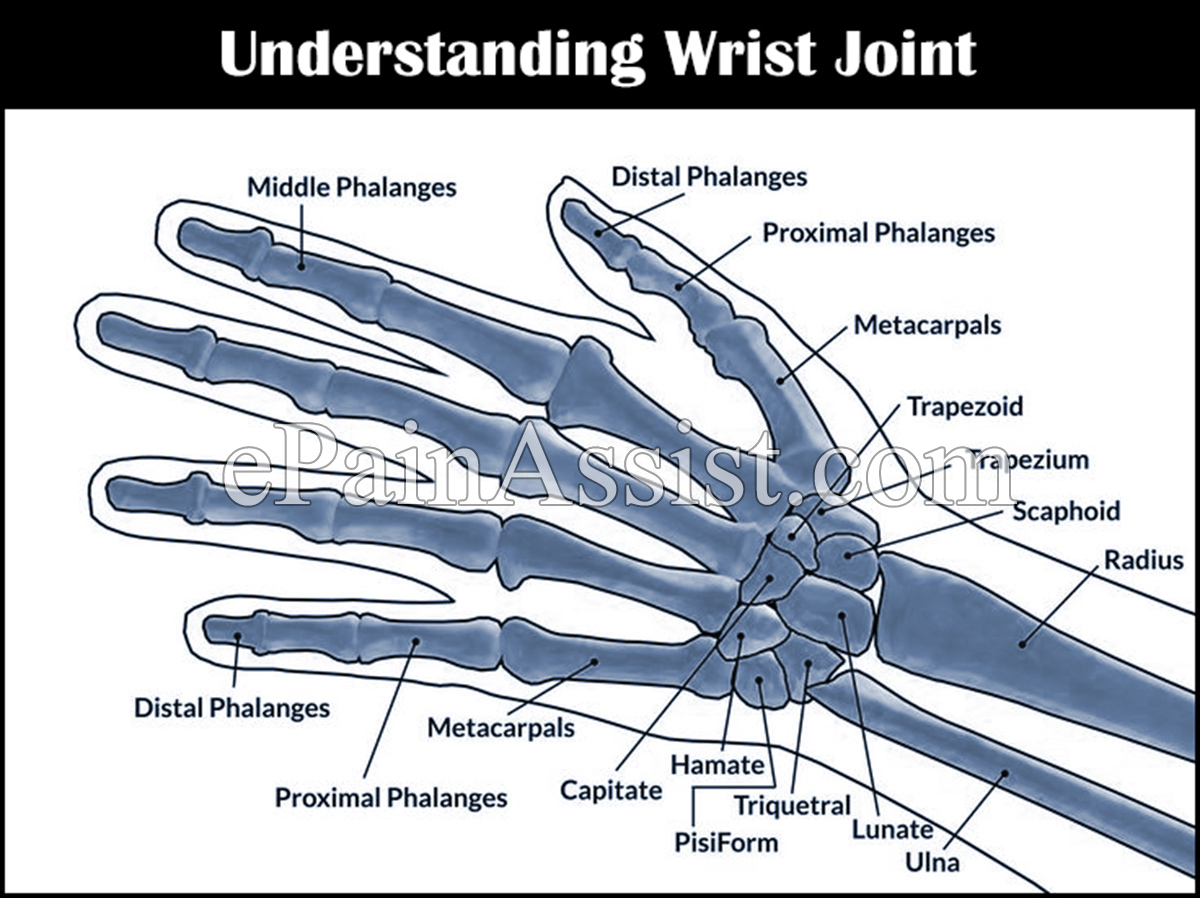Understanding Wrist Joint
Wrist Joint is also known as Radiocarpal Joint. Wrist joint or Radiocarpal Joint internal articulating surface is covered by synovial membrane. Wrist joint is divided into proximal, middle, and distal compartments.

Proximal Wrist Joint Compartment-
- Proximal wrist joint is formed between distal end (near wrist) of radius and ulna; and four small carpal bones.
- Proximal wrist joint also involves a joint between radius and ulna.
Middle Wrist Joint Compartment-
- Middle wrist joint is formed by links between eight small carpal bones lying adjacent to each other in proximal (facing head of radius and Ulna) and distal rows (facing head of metacarpal bone).
Distal Wrist Joint Compartment-
- Distal wrist joint involves a link between four carpal bones of second row and proximal (near wrist) head of the metatarsal bone.
What are the Other Soft Tissues Involved In Wrist Joint or Radiocarpal Joint?
Wrist joint is a complex joint formed by following structures-
- Retinaculum-
- Carpal Tunnel or Flexor Retinaculum (front of the wrist joint).
- Extensor Retinaculum (back of the wrist joint).
- Ligaments– Several ligaments linking all bones.
- Tendons- Several tendons are associated with wrist joint.
Describe The Proximal Wrist Joint or Radiocarpal Joint?
Proximal wrist joint compartment has 2 sets of joint.
- Ellipsoid Radio-Carpal Joint- The joint is a link between articular disc of radius and proximal row of carpal bones. Carpal bones forming joint with radius are scaphoid, lunate, and triquetral carpal bones.
- Radius-Ulna Joint- Radius and ulna are linked by an anterior and posterior ligament connecting the two bones. Radius and Ulna rotates to accomplish pronation and supination movement without separation or subluxation because of ligaments holding the joint.
Structure of Wrist Joint or Radiocarpal Joint
List The 8 Carpal Bones of The Wrist Joint or Radiocarpal Joint?
Eight small carpal bones are placed in proximal and distal rows
Proximal Row: Names of the carpal bones of first row
- Scaphoid
- Lunate
- Triquetrum
- Pisiform
Distal Row: Name of the carpal bone of the second row
- Trapezium
- Trapezoid
- Capitate
- Hamate
What Are The Different Types Of Fracture Of Wrist Joint or Radiocarpal Joint?
Most common fracture is Colles’ fracture and fracture of scaphoid bone.
- Distal Radius Fracture also known as Colles Fracture–
- Distal Ulnar Fracture
- Carpal Fracture–
- Radiocarpal
- Intercarpal
- Midcarpal
- Carpometacarpal
- Intermetacarpal joints
What Is The Function of Extensor Retinaculum?
Extensor retinaculum lies on dorsal side of the wrist under the skin. Extensor muscle tendon passes between the extensor retinaculum and the underlying bones. Extensor retinaculum prevents the herniation of tendon under the skin during bending and movements of the wrist. Bending and movements of the wrist joint may displace the tendon in the direction of least resistance resulting in bowstrings shape of herniation of the extensor tendon. Extensor retinaculum prevents the herniation.
What Is The Function of Flexor Retinaculum?
Flexor retinaculum lies on palmer side. The space or tunnel between flexor retinaculum and underlying bones is known as Carpal Tunnel. Flexor retinaculum protects the median nerve and flexor muscle tendons, which are located within carpal tunnel underneath the flexor retinaculum.
What Are The Different Movements Of The Wrist Joint or Radiocarpal Joint?
Different movements of the wrist joint are as follows-
- Flexion- Wrist is bent towards the palmer surface of forearm.
- Extension- Wrist is bent towards the dorsal surface of the forearm.
- Abduction or Radial Deviation- Hand movement towards the thumb.
- Adduction or Ulnar Deviation- Hand movement toward little finger.
- Pronation- Rotation of hand towards body.
- Supination- Rotation of hand away from the body.
Which Are The Muscles Involved In Wrist Joint Abduction or Radial Deviation?
- Extensor Carpi Radialis Longus
- Abductor Pollicis Longus
- Flexor Carpi Radialis
- Flexor Pullisis Longus
Which Are The Muscles Involved In Wrist Joint Adduction or Ulnar Deviation?
- Extensor Carpi Ulnaris
- Flexor Carpi Ulnaris
- Extensor Digitorium
- Extensor digiti minimi
Which Are The Muscles Involved In Wrist Extension or Dorsiflexion?
Wrist extension is also known as a dorsiflexion.
- Extensor Digitorium
- Extensor Carpi Radialis Longus
- Extensor Carpi Radialis Brevis
- Extensor Indicis
- Extensor Pollicis Longus
- Extensor Digiti Minimi
- Extensor Carpi Ulnaris
Which Are The Muscles Involved In Wrist Flexion Or Palmer Flexion?
Palmer flexion is much stronger than palmer extension or dorsiflexion.
Muscles involved in palmer flexion are –
- Flexor digitorum Superficialis
- Flexor digitorum profundus
- Flexor Carpi Ulnaris
- Flexor carpi Longus
- Flexor Carpi Longus
- Flexor Carpi Radialis
- Pollicis Longus
What Is Pronation And Supination Movement?
Pronation and supination is the rotation movement that occurs at the proximal wrist joint between radius and ulna.
- Pronation– Rotation of hand towards body
- Supination– Rotation of hand away form body
What Is Carpal Tunnel?
Carpal tunnel is a channel between flexor retinaculum (transverse carpal ligament) and underlying bones. Carpal tunnel contains tendons and median nerve.
- Tendons- Finger flexors (9 tendons) course through tunnel
- Nerve- Median Nerve
- Triangular Fibrocartilage Complex (TFCC)
What is Guyon’s Canal?
Guyon’s Canal lies between flexor retinaculum and to the pisiform and volar bone. Guyon’s canal is formed by a split in flexor retinaculum enclosing ulnar nerve and artery. Narrowing of canal can cause Ulnar Nerve pinch within the canal resulting in symptoms like tingling, numbness, or weakness. The syndrome is common among cyclist and thus known as handlebar palsy.
- Anatomy, Shoulder and Upper Limb, Wrist Joint https://www.ncbi.nlm.nih.gov/books/NBK534779/
- The Wrist Joint https://teachmeanatomy.info/upper-limb/joints/wrist-joint/
- Wrist Joint https://www.sciencedirect.com/topics/medicine-and-dentistry/wrist-joint
Also Read:
- Wrist Joint Fracture: Types, Causes, Symptoms, Treatment- Medications, PT, Surgery
- Major Causes of Wrist Pain on Pinky Side & Its Symptoms, Treatment
- Wrist Dislocation: Types, Causes, Signs, Symptoms, Treatment, Exercises, Investigations
- Broken Wrist: Types, Causes, Signs, Symptoms, Treatment, Exercises, Tests
- Wrist Strain: Types, Causes, Symptoms, Treatment, Recovery, Exercises


